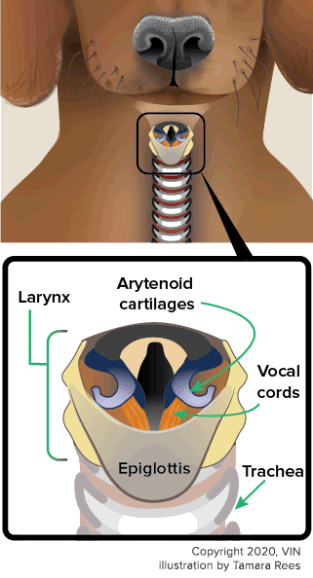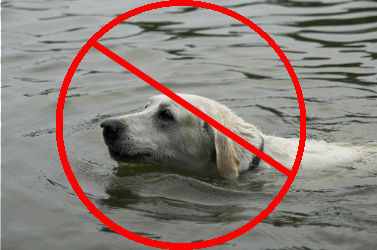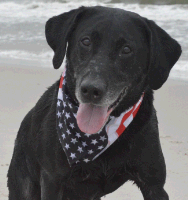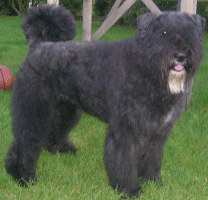What Animal Groups Can Get Laryngeal Paralysis
LARYNGEAL PARALYSIS
(GERIATRIC ONSET LARYNGEAL PARALYSIS AND POLYNEUROPATHY)
![]()
Well-nigh of us know the larynx is commonly known equally the "Voice Box" and it is located in the throat. We know that "laryngitis" is a status where one cannot speak merely other than that, the larynx does not go much thought. It is a vastly under appreciated organ. The larynx is not simply where sound comes from; information technology is more importantly the cap of respiratory tubing. The larynx closes the respiratory tract off while we eat and drink and so that we practice not inhale our food. If nosotros need to take a deep breath, the muscles of the larynx aggrandize and open for usa. The larynx is the guardian of the airways, keeping whatever we desire to consume out and directing air in.
| Laryngeal paralysis results when the abductor muscles of the larynx cannot work properly. This ways no expanding and opening of the larynx for a deep breath; the laryngeal folds simply flop weakly and flaccidly. In other words, when one needs a deep breath, ane doesn't go one. This can create tremendous feet (imagine attempting to accept a deep jiff and finding that you just cannot). Feet leads to more rapid deep breathing attempts and more distress. A respiratory crisis from the fractional obstacle can emerge creating an emergency and fifty-fifty expiry. Laryngeal paralysis does not come about suddenly. For most dogs there is a adequately long history of panting, hands tiring on walks, or loud raspy breathing. Ideally, the diagnosis can be fabricated before the status progresses to an emergency. |  |
| Dogs with laryngeal paralysis demonstrate some or all of the following signs:
The usual patient is an older large brood dog with the nigh usually afflicted breed existence the Labrador retriever. The condition can occur in the cat but is rare. The Bouvier des Flandres has a hereditary course of laryngeal paralysis which is able to affect young dogs. Other breeds reported to take early on onset genetic laryngeal paralysis include: Siberian Croaking, Great Pyrenees, bull terrier, and Dalmatian. These dogs are said to accept "congenital laryngeal paralysis" while older dogs that develop their laryngeal paralysis in old or heart age are said to have "acquired laryngeal paralysis." | Labrador retriever | Bouvier des Flandres |
IS LARYNGEAL PARALYSIS PART OF A BIGGER NEUROLOGIC Trouble?
The fourth dimension for ambiguity regarding this question has passed and the respond is a definite "yes." Laryngeal paralysis is now considered to be the first symptom of a much more pervasive neurologic weakness, hence the new name of the status to "Geriatric Onset Laryngeal Paralysis and Polyneuropathy." In time, the leg muscles will become weak and incoordinated leading to debilitating mobility problems. In add-on, the esophagus (the tube that carries food from the throat to the breadbasket) will lose normal office creating a risk for the inhalation of food fabric. This tin progress to a completely flaccid esophagus called a "megaesophagus," a status that requires loftier maintenance management to prevent aspiration pneumonia and provide proper food delivery.
The skilful news is that the boilerplate patient with acquired laryngeal paralysis is at least x years erstwhile and the progression of the neurologic weakness is fairly tiresome. This ways many patients will live their normal lifespan earlier farther neurologic weakness becomes a problem. We tin yet say, however, that dogs with laryngeal paralysis are 21 times more likely to develop a megaesophagus than are dogs without laryngeal paralysis. Also, it if 1 knows that a progressive muscle weakness is coming, one tin be proactive with exercise and physical therapy to assistance maintain mobility as long as possible.
The proffer has been made that hypothyroidism may exist a crusade of laryngeal paralysis. In fact, it is not. Hypothyroidism is associated with other neuropathies which could complicate the polyneuropathy of which laryngeal paralysis is a part. This means hypothyroidism should be identified and treated only, while improvement in weakness etc. may exist seen, the laryngeal paralysis will non reverse with thyroid hormone supplementation.
MAKING THE DIAGNOSIS
In order to decide if a canis familiaris has laryngeal paralysis, the larynx must be examined and this requires sedation. The level of sedation must be heavy plenty to allow the larynx to be inspected but light plenty for the patient to be taking some deep breaths. If the sedation is too deep for the diagnosis to be obvious, a respiratory stimulant chosen Dopram® (doxapram hydrochloride) is given intravenously to stimulate several deep breaths so that the function of the larynx is clear. In a normal larynx, the arytenoid cartilages are seen to open and shut widely. In a paralyzed larynx they only sit there limply while the patient breathes securely.
If the patient is having a respiratory crunch when he or she sees the veterinarian, this diagnostic examination can hands be followed by intubation (inserting a breathing tube down the patient'southward throat). This relieves the upper airway obstruction and the patient can exhale unremarkably, unfortunately, sedation must be maintained to keep the tube in identify. This potentially poses a trouble when the patient must wake up and the tube must exist eventually removed. If waking upward involves also much respiratory move, the patient may accept to exist re-sedated and the tube put back in until some other endeavour at waking tin can exist managed.
A newer technique of visualizing the larynx involves threading an endoscope downwards the patient's nostril. This is tricky simply the benefit is that sedation is not required. The downside is that specialized equipment is needed and the patient may not be cooperative.
Boosted TESTING
In that location are some additional tests that are helpful in evaluating the patient with laryngeal paralysis. Chest radiographs are important in ruling out aspiration pneumonia (from inhaling food material through the not-functional larynx), megaesophagus (which we have mentioned tremendously complicates a laryngeal paralysis case), and obvious tumor spread. Radiographs of the throat to rule out obvious pharynx tumor are also helpful. Consummate blood testing including thyroid tests should too be included in the piece of work-up.
Conservative TREATMENT
Treatment of laryngeal paralysis is well-nigh likely going to require surgery but not everyone is ready or able to provide a surgical solution for their dog. Here are some tips for not-surgical direction:
- Change from collar to harness to avoid pressure on the larynx.
- Avoid oestrus or other situations where the dog might pant.
- Reduce activeness (likewise then as to reduce panting)
- Tranquilizers or anti-anxiety medications may have benefit.
THE CRISIS
If laryngeal paralysis is not treated, a respiratory crisis tin can emerge. In this situation, the patient attempts to exhale deeply and simply cannot, creating a viscious cycle of feet and respiratory attempts. The laryngeal folds become swollen making the obstacle in the throat still worse. The patient'south gums become bluish in color from lack of oxygen and the patient begins to overheat. For reasons that remain unclear, fluid begins to flood the lungs and the patient begins to drown (as if the laryngeal obstruction wasn't lethal enough).
The patient must be sedated, intubated and cooled downwards with h2o in order to survive. Every bit soon every bit intubation is effected, the patient can breathe normally, oxygen can be administered and the crisis tin be concise if information technology has not progressed besides far.
Of class, eventually the patient will have to wake up and be able to survive without medical equipment. Corticosteroids can be used to reduce the swelling but ideally one of several surgical solutions is needed.
SURGICAL SOLUTIONS
The goal of surgery, whichever technique is used, is to relieve the airway obstruction permanently while maintaining the original function of the larynx (protection of the airways).
Laryngeal Tieback (too called Lateralization Surgery)
This has probably become the most commonly performed surgery for laryngeal paralysis currently. It involves placing a couple of sutures in such a way as to pull one of the arytenoid cartilages backward. By repositioning one of the arytenoids the opening of the larynx is changed (fabricated larger). The principal complication of this procedure stems from the fact that merely a few millimeters of position change in the arytenoids are needed. If the cartilage is moved too much, the larynx cannot properly shut and aspiration pneumonia becomes a substantial risk. Unremarkably these patients have a persistent cough after eating or drinking. This surgery has been associated with a fourteen% postoperative mortality rate. (In older times, both arytenoids were tied back to create a withal larger larynx merely tying off both cartilages in this way was associated with a 67% bloodshed rate and so it is no longer washed).
Partial Arytenoidectomy
Another surgical technique involves only bitter out one vocal fold and too biting out the arytenoids cartilage on the aforementioned side. In that location is more than haemorrhage with this technique and a tracheostomy becomes more desirable. Surgeries involving removing part of the larynx have been associated with a thirty% mortality rate in laryngeal paralysis patients.
Castellation
In this surgery, a square of the thyroid cartilage is cut (similar to a castle's turret's square behind which an archer might hibernate). This square is moved forward and reattached to create a wider laryngeal opening. A tracheostomy is often needed to protect from swelling.
Ventriculocordectomy (De-Barking)
De-barking surgery is mostly thought of every bit a surgical solution to a behavioral trouble merely information technology is as well a fair handling for laryngeal paralysis. The usual method involves extending a long "biting" forcep downward the throat and bitter out the vocal folds. Obviously anesthesia is needed to do this and the fact that the surgical area is the larynx makes normal intubation for anesthesia impossible. This means either using injectable anesthesia or placing a tracheostomy (cut a hole in the throat lower down) and intubating through that.
Removal of the vocal folds, of grade, also removes the patient's voice reducing barking to a whisper. The hole created by the absence of the song folds makes for a larger airway opening and is by and large big enough to salvage the obstacle. Complications of this surgery include swelling and bleeding (which tin cause obstruction in themselves, though, if a tracheostomy is placed any such obstruction is bypassed), and regrowth of a webbing of vocal tissue. An alternative technique involves budgeted the larynx from the outside of the throat instead of down the oral cavity. This method is more than hard and time consuming but has less run a risk of the development of webbing. A tracheostomy, if whatsoever, is allowed to heal airtight.
Mail-OPERATIVE CONSIDERATIONS
| In that location are some special concerns afterward laryngeal surgery regardless of the procedure:
|  After Laryngeal Surgery, No Swimming Should be Permitted! After Laryngeal Surgery, No Swimming Should be Permitted! The chance of water aspiration is too not bad. (Photocredit: Morguefile.com) |
ASPIRATION PNEUMONIA
While just nearly ten% of dogs being evaluated for surgical correction of laryngeal paralysis already have aspiration pneumonia, well-nigh 25% will develop aspiration pneumonia at some point. Pneumonia is ever potentially life-threatening and aspiration pneumonia is particularly difficult to clear since it involves big contaminated nutrient particles in the lung. Broad spectrum antibiotics, fluid therapy and concrete therapy are important tools but, sadly, the underlying condition that led to the original aspiration pneumonia, is probable to produce future episodes. Please visit the library department on Pneumonia Management for details on treatment.
![]()
Page final updated: 6/3/2022
Source: https://www.marvistavet.com/laryngeal-paralysis.pml
Posted by: smithbanke1953.blogspot.com



0 Response to "What Animal Groups Can Get Laryngeal Paralysis"
Post a Comment